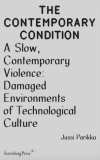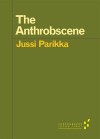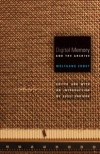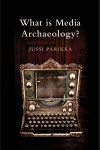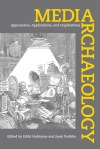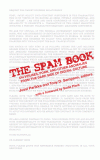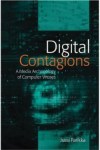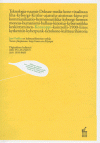The Media That Therefore We Are – on Lenore Malen’s video installation
I wrote this short catalogue text for Lenore Malen’s I am the Animal — also included stills (courtesy of and permission from Lenore Malen) from the exhibition:
The Media That Therefore We Are

It’s a matter of scales. If you are far enough away, and your perspective is mediated by a layer of concepts, abstractions, and an organizational eye, you might indeed see them as models of ideal society. It’s all order. Everyone does what they are supposed to. There is one Queen. No wonder the protofascist Maya the Bee was an ideal cartoon character for 1930s national-socialist Germany. One is tempted to see the idea of a strong leadership to which everyone submits as an example of sovereign power per se, even if, to be honest, the Queen does not choose to execute power — it happens much more intuitively, almost in a subconscious way. Of course, when it comes to bees, there is no such talk of subconscious; instinct used to be the word in the 19th century for this near mystical mode of organization. This is evident in, for instance, Maurice Maeterlinck’s The Life of the Bee (1901), which refers to “the spirit of the hive.”
But on another scale, it looks very different. Look closely enough and they become the aliens they are: their weird compound eyes composed of thousands of lenses, their six legs, non-human movement, jerky, non-mammal insides folded out. This has been the other story since the 19th century and the birth of modern entomology: insects as aliens, otherworldly non-humans, often seem almost to possess technology in their capacities to see, sense, and move differently. The insects are the Anti-McLuhan; technics does not start with the human but with the animal, the insect, and their superior powers of being-in the- world (the allusion to Heidegger is intentional).
 Lenore Malen’s I Am The Animal intertwines the various histories, aesthetics, and idealizations of the bee community as well as the bee’s relations withbeekeepers. It’s all about relations, and establishing relations with our constitutive environments — including bees. Donna Haraway talks about companion species (specifically dogs, but other animals too) as formative of our being in the world; she discusses the ways in which those relations are formative of our becomings.
Lenore Malen’s I Am The Animal intertwines the various histories, aesthetics, and idealizations of the bee community as well as the bee’s relations withbeekeepers. It’s all about relations, and establishing relations with our constitutive environments — including bees. Donna Haraway talks about companion species (specifically dogs, but other animals too) as formative of our being in the world; she discusses the ways in which those relations are formative of our becomings.
Our relation to insects is reflected in much more than the narrative aspect of Malen’s work. The immersive environment of the installation envelops the spectator in a milieu of becoming. The clips Malen uses are mini-thoughts, mini-brains, which are brought together with her digital software tools; the clips are memes that Malen excavates from online archives and audiovisual repositories, and composes into a three-channel envelope.
I Am The Animal poses the question: Can insects be our companion species? This is paradoxical in light of Derrida’s The Animal That Therefore I Am, to which Malen’s title refers. Derrida starts with the gaze of the animal — his cat, to be exact, lazily gazing at Derrida’s naked body. But catching the insect’s compound eyes is more difficult, if not impossible. For Malen, Derrida’s essay functions as a critique of subjectivity. Derrida continues to analyze how the cat does not feel its own nakedness, has no need of clothes, whereas we — as technical beings — surround our bodies, envelop ourselves in extensions, such as clothes. We are not only enveloped in cinema, media, and technology but in fundamental forms of shelter.
So do animals have technology? They might not plan buildings and produce external tools, but an alternative lineage claims that animals, insects and such, are completely technical. Henri Bergson was of such an opinion: even if humans are intelligent in the sense of being able to abstract, plan, and externalize their thoughts into tools, insects occupy technics in their bodies and embody intertwining with the world. The body itself is already technical. One could think of examples of insect architecture, of various stratagems of the body for defense or attack, of modes of movement, and of perception as media. If the body is media — as Ernst Kapp suggested in the 19th century and McLuhan later — then what kind of media does the insect suggest?
The three screens of I Am The Animal are rhythmic elements that deterritorialize our vision. A slowly progressing multiplication of viewpoints is the becoming-animal of perception that the installation delivers. The immersive space is also one of measured fragmentation into the compound vision of insects. Slow disorientation is one tactic of this mode of becoming; it points both to the world of insects and to the media in which we are immersed. The early avant-garde connection between the technical vision machine and the insect compound machine — in the words of Jean Epstein, “the thousand-faceted eyes of the insects” — creates a sense of space as split; perspective is multiplied into a variation. Malen’s I Am The Animal is about such forms of multiplicity.
The animal is incorporated into the machinated cultural assemblages of modernity; the disappearance of animals from urban cultures during the past couple hundred years is paralleled by the appearance of animals in various modern discourses from media to theory. We talk, see, incorporate animal energies. Akira Mizuta Lippit in Electric Animal (2000) writes how “the idioms and histories of numerous technological innovations from the steam engine to quantum mechanics bear the traces of an incorporated animality. James Watt and later Henry Ford, Thomas Edison, Alexander Graham Bell, Walt Disney, and Erwin Schrödinger, among other key figures in the industrial and aesthetic shifts of the late nineteenth and early twentieth centuries, found uses for animal spirits in developing their respective machines, creating in the process fantastic hybrids.”
Animals as well as media are elements with which we become. Matthew Fuller in his essay “Art for Animals” (2008) identifies a two-fold danger in relation to art with/about nature: that we succumb to a social constructionism or that we embrace biological positivism. And yet, we need to be able to carve out the art/aesthetic in and through nature and animals in ways that involve the double movement back and forth between animality and humanity. Art for animals is one way, to quote Fuller: “Art for animals intends to address the ecology of capacities for perceptions, sensation, thought and reflexivity of animals.” What kind of perceptions and sensations are afforded us by media/ nature? And conversely, what worlds do we create in which animals and nature perceive, live, and think?





